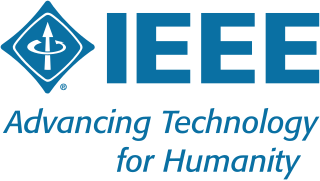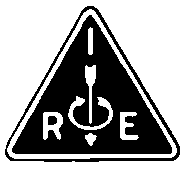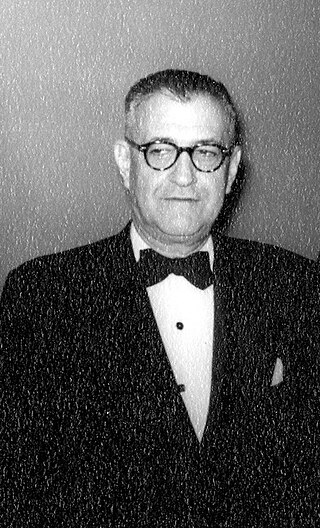
The Institute of Electrical and Electronics Engineers (IEEE) is an American 501(c)(3) professional association for electronics engineering, electrical engineering, and other related disciplines.

The Institute of Radio Engineers (IRE) was a professional organization which existed from 1912 until December 31, 1962. On January 1, 1963, it merged with the American Institute of Electrical Engineers (AIEE) to form the Institute of Electrical and Electronics Engineers (IEEE).

Robert Gray Gallager is an American electrical engineer known for his work on information theory and communications networks.

Henryk Władysław Magnuski was a Polish telecommunications engineer who worked for Motorola in Chicago. He was a primary contributor in the development of one of the first Walkie-Talkie radios, the Motorola SCR-300, and influenced the company's success in the field of radio communication.
The American Institute of Electrical Engineers (AIEE) was a United States-based organization of electrical engineers that existed from 1884 through 1962. On January 1, 1963, it merged with the Institute of Radio Engineers (IRE) to form the Institute of Electrical and Electronics Engineers (IEEE).

Walter Ransom Gail Baker was an American electrical engineer. He was a vice president of General Electric, and was Director of Engineering for the Radio Manufacturers Association. At the urging of James Lawrence Fly, Chairman of the Federal Communications Commission (FCC), Baker founded the National Television System Committee, or NTSC, in 1940. He served as president of the Institute of Radio Engineers (IRE) in 1947.
Dr. Lawrence Jerome Fogel was a pioneer in evolutionary computation and human factors analysis. He is known as the inventor of active noise cancellation and the father of evolutionary programming. His scientific career spanned nearly six decades and included electrical engineering, aerospace engineering, communication theory, human factors research, information processing, cybernetics, biotechnology, artificial intelligence, and computer science.
Ernst Adolph Guillemin was an American electrical engineer and computer scientist at the Massachusetts Institute of Technology who spent his career extending the art and science of linear network analysis and synthesis. His nephew Victor Guillemin is a math professor at MIT, his nephew Robert Charles Guillemin was a sidewalk artist, his great-niece Karen Guillemin is a biology professor at the University of Oregon, and his granddaughter Mary Elizabeth Meyerand is a Medical Physics Professor at the University of Wisconsin-Madison.
The IEEE Vehicular Technology Society (VTS) was founded in 1949 as the Institute of Radio Engineers' (IRE) Committee on Vehicular and Railroad Radio. The Society's name has changed five times since then and its scope has expanded to include not only the "Radio" of the original name, but all manners of electronics associated with vehicular systems. The Society held its first "Meeting" in Detroit in 1950. The Society's first Transactions was published in 1952. Like the Society, the Transactions has carried many names. The Society has approximately 45 local chapters throughout the world.
James R. Wait was a Canadian electrical engineer and engineering physicist. In 1977, he was elected as a member of National Academy of Engineering in Electronics, Communication & Information Systems Engineering for his contributions to electromagnetic propagation engineering as it affects communication and geophysical exploration.
Behzad Razavi is an Iranian-American professor and researcher of electrical and electronic engineering. Noted for his research in communications circuitry, Razavi is the director of the Communication Circuits Laboratory at the University of California Los Angeles. He is a Fellow and a distinguished lecturer for the Institute of Electrical and Electronics Engineers. Among his awards, Razavi is a two-time recipient of the Beatrice Winner Award for Editorial Excellence at the 1994 and 2001 International Solid-State Circuits Conferences. In 2017, he was elected as a member into the National Academy of Engineering for contributions to low-power broadband communication circuits.
The IEEE Professional Communication Society(IEEE ProComm) is a professional society of the Institute of Electrical and Electronics Engineers (IEEE). Its primary goals include helping engineers and technical writers to pursue further education and research in their fields, in addition to development of standards in technical communication. The society runs the annual IEEE International Professional Communication Conference, known as ProComm (formerly known as IPCC).
Donald Glen Fink was an American electrical engineer, a pioneer in the development of radio navigation systems and television standards, vice president for research of Philco, president of the Institute of Radio Engineers, General Manager of the IEEE, and an editor of many important publications in electrical engineering.
The Proceedings of the IEEE is a monthly peer-reviewed scientific journal published by the Institute of Electrical and Electronics Engineers (IEEE). The journal focuses on electrical engineering and computer science. According to the Journal Citation Reports, the journal has a 2017 impact factor of 9.107, ranking it sixth in the category "Engineering, Electrical & Electronic." In 2018, it became fifth with an enhanced impact factor of 10.694.
The IEEE Transactions on Signal Processing is a biweekly peer-reviewed scientific journal published by the Institute of Electrical and Electronics Engineers covering research on signal processing. It was established in 1953 as the IRE Transactions on Audio, renamed to IEEE Transactions on Audio and Electroacoustics in 1966 and to IEEE Transactions on Acoustics, Speech, and Signal Processing in 1974, before obtaining its current name in 1992. The journal is abstracted and indexed in MEDLINE/PubMed and the Science Citation Index Expanded. According to the Journal Citation Reports, the journal has a 2022 impact factor of 5.4. The editor-in-chief is Wing-Kin (Ken) Ma.
IEEE Transactions on Aerospace and Electronic Systems is a bimonthly peer-reviewed scientific journal published by the IEEE Aerospace and Electronic Systems Society. It covers the organization, design, development, integration, and operation of complex systems for space, air, ocean, or ground environment. The editor-in-chief is Gokhan Inalhan. According to the Journal Citation Reports, the journal has a 2020 impact factor of 4.102.
Ranjan Kumar Mallik is an Indian electrical and communications engineer and a professor at the Department of Electrical Engineering of the Indian Institute of Technology, Delhi. He held the Jai Gupta Chair at IIT Delhi from 2007 to 2012 and the Brigadier Bhopinder Singh Chair from 2012 to 2017. He is known for his researches on multiple-input multi-output systems and is an elected fellow of all the three major Indian science academies viz. Indian Academy of Sciences, Indian National Science Academy, and The National Academy of Sciences, India. He is also an elected fellow of The World Academy of Sciences, Indian National Academy of Engineering, and The Institute of Electrical and Electronics Engineers, Inc.
Jack Justin Stiffler (1934–2019) was an American electrical engineer, computer scientist and entrepreneur, a Fellow of the Institute of Electrical and Electronics Engineers who made key contributions in the areas of communications and fault-tolerant computing.
Subbarayan Pasupathy was a Canadian electrical engineer and a professor emeritus of Electrical and Computer Engineering at University of Toronto. He also served as the Chairman of the Communications Group and as the Associate Chairman of the Department of Electrical Engineering, University of Toronto.




